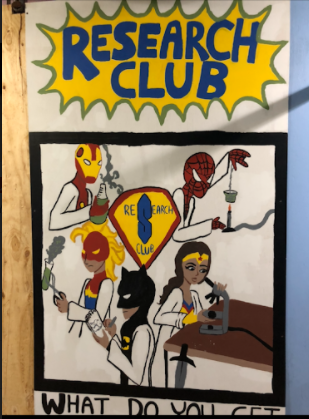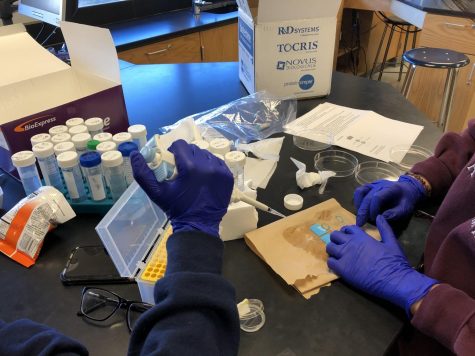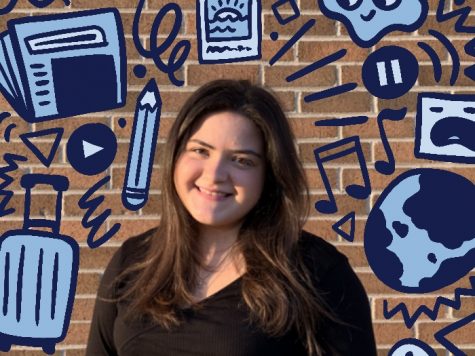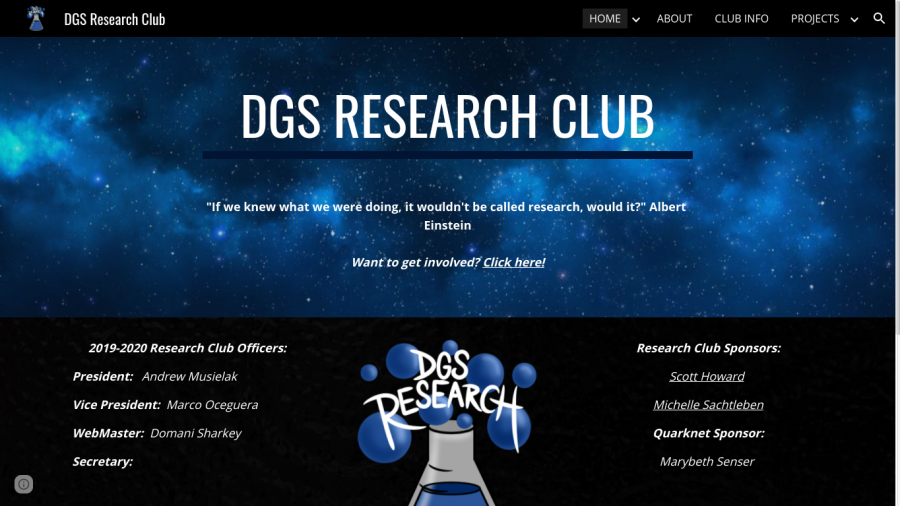Under the microscope: An inside look at DGS’s Research Club
DGS Research Club offers students the opportunity to conduct their own long-term research projects.
Stepping into Research Club, there’s a sense of controlled chaos. In one corner, students laugh with each other while pouring and mixing different liquids in beakers while in another, a student sits with their chromebook open, eyebrows furrowed as they scribble notes. Everyone is busy and focused, and though there are multiple projects going on, there is an orderliness to every action that grounds the flurry of multi-tasking.
The club has been run by DGS chemistry teachers Michelle Sachtleben and Scott Howard since its start in 2015. Partnering with Lewis and Midwestern University, Research Club offers high school students the opportunity to manage their own long term research projects.
“The students are actually working with mentors from the universities in guidance with experimental design, problem solving, how to analyze their data, the statistical packages with that and then the general things that come up with experimenting on a multi-month to year scale that is unfamiliar to every kid in Research Club,” Howard said.
Using discarded graduate projects, ideas from scientific journals and communication with college professors and students, Sachtleben and Howard present the students with a range of possible projects to choose from.
“Coming up with an original idea is very difficult for a novice science student, which highschoolers are, and that’s completely fine… we sort of say, here’s what you can do, and whatever is attractive to you, pursue it,” Howard said.

A wood-painting created by the Research Club for the 2019-2020 school year.
The focus and activities of each meeting depends on the student and what they are researching. Topics range from protecting pilots’ eyes from lasers that distract them while landing, a bandage that dispenses drugs intermittently and even a botany project centered around creating a garden of native plants on the DGS campus.
This year, DGS juniors Rainu George and Annie Le focused their research on the destruction of cancer cells. The project stems from their shared interest in medicine.
George, who has been a member since her sophomore year, had not planned to join Research Club but says she changed her mind during her sophomore year after seeing the work of other women in fields of research.
“I was inspired by the women in science and what they did. I was holding off joining any type of research till college but it was the initiative and motivation of these women in STEM that made me want to do research as a high schooler,” George said.
George has been an active participant since, learning the ins and outs of continuous experimentation and research.
“Research Club is giving me a head start for college. I’m learning the procedural work of a lab, writing hypotheses, reading published research, understanding data, developing my hypotheses and so much more. It is also helping [members] connect to researchers and understand the standards of professional research,” George said.
The project that George and Le have collaborated on this year in tandem with Midwestern University aims to train the immune system to destroy cancer cells. They communicate updates to Michelle Swanson, a professor of immunology, for guidance.
“This year, our experiment pertains to the role that Epstein-Barr virus, which is better known as mono, plays in the growth of tumors. Our research specifically is meant to try to determine whether or not a certain protein of this virus phosphorylates in order to create communication pathways between the nucleus of the cell and the virus which would allow the virus to command the cell to begin multiplying and proliferating. We’re using mice tumors in this experiment since it’s been seen that mice and humans have pretty similar responses to disease,” Le said.
George and Le hope that by examining the relationship between the Epstein-Barr virus and the immune system, they can aid in the advancement of immunotherapy practices.
“By examining the effects of Epstein-Barr virus, which over 90% of the population has, and the consequent weakening of your immune system that it creates, we can understand how we can better prepare your immune system for foreign invaders such as cancer,” George said.
When a student first joins Research Club, there’s a variety of projects they can choose from to get started with. Le, who joined this year, details why she chose this project in particular.
“I joined at a point in which not many groups had started their lab work yet, so there were a few different projects that I could’ve joined, but this project interested me a lot because of the impact that these discoveries could potentially have in the future of medicine and cancer research,” Le said.
Among knowledge of scientific practices, the project also required an understanding of biology that, as high school students, George and Le didn’t possess. This meant that much of their time was spent finding, learning and conceptualizing concepts in Biomedical science that would aid them in bettering each trial of their research.
While in the process of running their experiment, Le and George found that patience with the trial and errors was tantamount. Learning to take failures in stride ensured that the experiment would run smoothly.
“One thing that’ll always be a bit baffling to hear is inconclusive results from an experiment that ran fine. There’s been times when we carried out the experiment nearly perfectly and yet that run of the experiment failed, but, again, science isn’t always perfect and there will always be failed experiments, even those that are carried out in professional lab settings,” Le said.

George and Le work on their experiment which they hope will help make advancements in immunotherapy treatment.
Le found another hurdle while running the experiment — down time. The lab required times where the experiment needed to run its course and she couldn’t do anything but wait. Finding what exactly to do with that time was another challenge.
“You never think about having to wait for a really long time when you’re performing experiments like these, and yet, in our experiment specifically, we have two incubation periods of about thirty minutes each where you literally can’t do anything because you can’t just come back to it in the morning and you also can’t just carry on with the next step. But I suppose that’s also something that I learned from this whole experience — how to wait or find something productive to do while doing so,” Le said.
Before the cancellation of large scale gatherings due to the COVID-19 pandemic, George and Le had planned to share their research competitively. Sachtleben shares how members of Research Club have the opportunity to present and share their work with their peers at the Illinois State University symposium that the club attends annually.
“As far as our competitions work, there’s a poster that’s put together by the different research groups and they will go and present their research. Different schools will go down and any of the kids who do research can go and present their work,” Sachtleben said.
Members who wish to do so can submit their work to compete against other projects at the symposium.
“There’s also an option where two students maximum can go in front of a judge [that is] judging their area of research and they would compete against other students. They would present their research and defend their hypothesis and what they did and how they got it,” Sachtleben said.
Howard shares his belief that displaying studentwork before others is what completes the learning process of executing research.
“We try to motivate [the students] by saying that doing any project for an extended period of time will improve your understanding of science, your ability to perform different lab skills, the analysis, and then going to present that to an audience is what sort of closes the loop,” Howard said.
George and Le are currently waiting to hear from Illinois University on whether they can submit their work digitally. With students unable to return to school for the remainder of the 2019-2020 school year due to the implementation of remote-learning, all of the members of Research Club have been unable to access any equipment or materials necessary for their experiments that were left behind at school. However, despite an inability to continue their projects in the classroom, students can always reflect on the lessons they’ve learned while being a part of the club.
“I’ve learned quite a lot from Research Club. I’ve been able to learn what a real lab set-up is like and how to use various different experimental instruments. I’ve also learned how to be simultaneously efficient and careful with the lab work as the cycles of lab work have passed– though I feel like the most important thing that someone could learn from Research Club is that we all mess up sometimes and that’s okay because that’s just a part of the scientific process,” Le said.
Sachtleben hopes the students will take away more than just the scientific knowledge they gain from their experiences. She shares what lessons she wants students to gain from participating in the club.
“Research is not done overnight. Research can be confusing and you don’t always get the results you’re looking for, so perseverance is important. The ability to think critically and definitely being able to build a sense of collaboration with other student scientists. And of course, pride in the good work they’re doing,” Sachtleben said.
In the future, Sachtleben and Howard both hope that the new STEM wing of the school building will offer students the ability to advertise their work to the student body. If you are interested in learning more about Research Club, visit their website, linked here.



